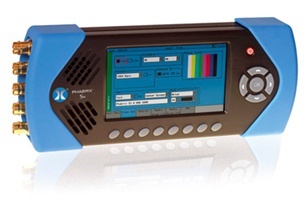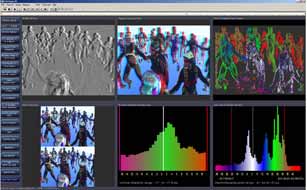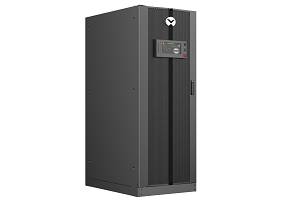The switchover from analog to digital production should in theory have resulted in much smaller demand for broadcast test equipment. Digital technology has in reality given broadcasters a wide range of new opportunities, each generating a new set of challenges. This article looks at some of the most recently introduced tools including many that will be demonstrated at the upcoming NAB Show in the Las Vegas Convention Centre, April 11-14.

The Agama Analyser from Agama Technologies provides real-time monitoring of digital TV services. It supports multiple metrics for DTV and supports MPEG-2 and MPEG-4/AVC video in SD and HD. Parameters such as IP packet jitter and packet loss are also measured. Multiple Analyser probes can be deployed across the distribution network, connected to an Agama server.
Blackmagic's UltraScope software is claimed to include all the test and measurement features required during 2D editing and colour correction. Compatible with Microsoft Windows, it is designed for connection to a 24 inch monitor and will then display six live scope views simultaneously. Features include a 3 Gbit/s optical fibre SDI interface. A miniature Pocket UltraScope is also available, connecting into the host PC via USB 3.0 interface.

Cel-Soft's Cel-Scope3D allows stereoscopic camera alignment to be performed quickly and confidently so that the 3D is accurate from the moment of capture. Available as a complete system or as Windows-compatible software, it can display left and right channels simultaneously plus actual depth dynamics. Its display window can each be set to show the usual waveform, vectorscope and histogram graphics as well as differences in video parameters between each channel. Geometry issues can be easily identified using built-in real-time image manipulation. Quality-control tests can be performed on live stereoscopic video sources in any SD, HD or 2K format from industry standard capture cards or Firewire inputs, or alternatively from file playback. An automatic logging option generates a printable report of depth budget and depth plot for easy reference by cameramen during a shoot or by editors during 3D post-production. It logs against timecode the maximum and minimum depth values employed in a 3D sequence. These measurements can be shown either in percentage of screen width or in horizontal pixels. A cursor can be placed on any object of interest or point of attention for a instant measurement of that spot's disparity and hence depth.
DK Technologies' PT0740M is an audio-only version of the PT0760M waveform monitor. Designed for users who do not need a video measurement tool, it offers de-embedding from a single HD/SD SDi input and full StarFish surround sound metering. Analogue and digital inputs and outputs, audio delay and Dolby decoding are provided. All of the products in DK’s PTO700 Series of waveform monitors can now be equipped with the company’s Loudness software, which is based on ITU algorithms and includes the 400 Hz and 1 kHz reference frequencies that are likely to be implemented by broadcast and advertising regulators. DK has also introduced a new software upgrade that enables users to see peak and loudness metering at the same time.
Dolby's DP600 Program Optimiser provides a wide range of audio tools for loudness correction, audio creation, conversion, and upmixing. It is designed for use in cable, satellite, IPTV, terrestrial TV, radio, and postproduction facilities. The DP600 includes intelligent audio analysis and automated loudness normalisation, along with the ability to encode, decode, convert, and transcode between Dolby Digital, Dolby Digital Plus, Dolby Pulse, and Dolby E bitstreams, as well as PCM, MPEG-1 LII, AAC, HE AAC, and HE AAC v.2. It also features a newly designed algorithm for upmixing legacy two-channel audio for 5.1-channel delivery. The DP600 also supports many broadcast media file and audio formats. Expanding on the Dolby Dialogue Intelligence technology developed for the LM100 Broadcast Loudness Meter, the DP600 normalises the loudness of audio programmes while preserving their original dynamic range.
Eyeheight's KARMAudioRT allows real-time unattended adaptive loudness and true-peak correction. It continually monitors the amplitude of incoming audio and makes gradual adjustments to ensure that the overall content complies with a predefined target loudness. These adjustments occur uniformly across all channels to ensure that relative image positions are unaffected. KARMAudioRT also performs true-peak estimation and correction at 8 x real-time oversampling frequency. KARMAudioRT conforms to the ITU-R BS.1770 recommendation and its US equivalent, ATSC A/85:2009 (Recommended Practice: Techniques for Establishing and Maintaining Audio Loudness for Digital Television). ITU-R BS.1770 and ATSC A/85:2009 were defined in response to growing pressure on broadcasters to prevent the loudness of advertisements and upcoming-programme promotional clips exceeding the apparent average loudness of prior and subsequent content.
Hamlet's DigiScope DS900 is quality-control instrument for use in production and master control environments. It is supplied in a half rack width 1 RU shallow cabinet. Internally it is based on the Hamlet digital modular test and measurement platform, with space for four internal input modules and a generator module. The DS900 is designed for 3 Gbit/s processing and measurement, modules being are available for all common analogue and digital standards. Measurements available include eye pattern for fast check on the security of a digital circuit. Test traces can be displayed on any suitable monitor. The DS900 has DVI and XVGA outputs as standard. Control is via tree touchscreen displays on the front of the unit. The left display allows the user to select one or all of the four available inputs, and the right the tests to be performed. The centre display acts as a confidence monitor allowing the operator to check that the correct signals and tests have been set.
Harris' SD-STAR is a handheld battery-powered monitor and test generator for SD-SDI and analog composite video signals. It features a video test signal generator, colour monitor, waveform monitor, vectorscope, oscilloscope and audio analyser/monitor.
Leader's new LG 3860 is a signal generator with optional encoding software supporting the different satellite digital broadcasting systems of various countries. An integral encoder and upconverter allow variation of channel frequencies and output levels. The generator is suitable for use as a simple loopback transmitter at a broadcast station. Features include still-image pattern and audio tone generation plus the ability to play back user-defined transport streams by connecting the LG 3860 to a PC through USB 2.0. Up to 40 preset configurationscan be saved in internal memory.
OmniTek's OTR 1001 is a 1 RU rackmount version of the company's OTM 1000 SDI waveform monitor and test signal generator, supporting all SD, HD, Dual Link and 3G video standards. Depending on the configuration options purchased, features include user-adjustable waveform and vectorscope displays, eye pattern and jitter displays with automated measurement of signal amplitude, Dolby D and Dolby E compressed audio decode and analysis, plus error detection and logging. The OTR 1001 is available with front panel control or configured for mouse & keyboard control.
Murraypro's Test Chest 3G is a handheld 10-bit video signal generator for 3G-HD, 1.4-HD or SD. A continuously moving puck can be added to any of the test signals generated, to catch downstream MPEG motion artifacts and synchroniser freezes. A circle of 16:9 or 12:9 format can be inserted, confirming the aspect ratio of the programme material or for checking local monitors. An alphanumeric ident can be overlaid. On 50i and 60i SD, a high-quality 625 or 525 composite video output is available.
Phabrix has introduced a Dolby E option for its Sx range. This allows the display of Dolby-E metadata present in a selected audio stream and determines whether the Dolby-E packet is timed correctly on the SDI video stream. Dolby-E can be monitored from any of the SDI input embedded audio channel pairs or the AES input. The Dolby-E metadata screen above carries primary information including signal source, Dolby-E guard-band timing, CRC errors, programme channel and metadata detail.
Pixelmetrix Electronic Couch Potato (ECP) provides feedback on various service quality parameters from set-to-boxes to a central site. Service plan verification, channel switching and multiple measurements on service quality for each channel are reported to a central management console. An automated channel package audit option can be used for quality assurance and monitoring of multi-region networks with central head-ends.
Prism Sound’s dScope Series 3 audio analyser now supports audio streaming directly between test system and Bluetooth device, enabling real-time, closed-loop testing of Bluetooth audio systems. It integrates analogue, digital (S/PDIF and I2S), electronic, electroacoustic and Bluetooth measurement capabilities in a single instrument.
Rohde & Schwarz R&S ETL combines the functions of a television and FM-radio signal analyser, video and MPEG transport stream analyser and a spectrum analyser in a single instrument. It also contains generators to create analog video signals, audio signals and MPEG-2 transport streams. Frequency range is 500 kHz to 3 GHz.
Tektronix VQS1000 Video Quality software can be combined with any Tektronix network probe to enable real time assessment of video impairments on MPEG-2 or H.264 encoded content, including stuck, black, blockiness and compression artifacts, for selected services. The software is designed to improve the accuracy of artifact measurement by performing a full decode on the video stream. The full decode allows operators to determine if the cause of a problem is in the content source (for example over-compression) or in network distribution. Operators can see and validate the presence of impairments on the image using displays that highlight the location and severity of video defects. In addition, audio diagnostics allow operators to analyse audio loudness-related problems to the ITU-R BS.1770/1771 Audio Loudness standard.
 The Agama Analyser from Agama Technologies provides real-time monitoring of digital TV services. It supports multiple metrics for DTV and supports MPEG-2 and MPEG-4/AVC video in SD and HD. Parameters such as IP packet jitter and packet loss are also measured. Multiple Analyser probes can be deployed across the distribution network, connected to an Agama server.
The Agama Analyser from Agama Technologies provides real-time monitoring of digital TV services. It supports multiple metrics for DTV and supports MPEG-2 and MPEG-4/AVC video in SD and HD. Parameters such as IP packet jitter and packet loss are also measured. Multiple Analyser probes can be deployed across the distribution network, connected to an Agama server. Cel-Soft's Cel-Scope3D allows stereoscopic camera alignment to be performed quickly and confidently so that the 3D is accurate from the moment of capture. Available as a complete system or as Windows-compatible software, it can display left and right channels simultaneously plus actual depth dynamics. Its display window can each be set to show the usual waveform, vectorscope and histogram graphics as well as differences in video parameters between each channel. Geometry issues can be easily identified using built-in real-time image manipulation. Quality-control tests can be performed on live stereoscopic video sources in any SD, HD or 2K format from industry standard capture cards or Firewire inputs, or alternatively from file playback. An automatic logging option generates a printable report of depth budget and depth plot for easy reference by cameramen during a shoot or by editors during 3D post-production. It logs against timecode the maximum and minimum depth values employed in a 3D sequence. These measurements can be shown either in percentage of screen width or in horizontal pixels. A cursor can be placed on any object of interest or point of attention for a instant measurement of that spot's disparity and hence depth.
Cel-Soft's Cel-Scope3D allows stereoscopic camera alignment to be performed quickly and confidently so that the 3D is accurate from the moment of capture. Available as a complete system or as Windows-compatible software, it can display left and right channels simultaneously plus actual depth dynamics. Its display window can each be set to show the usual waveform, vectorscope and histogram graphics as well as differences in video parameters between each channel. Geometry issues can be easily identified using built-in real-time image manipulation. Quality-control tests can be performed on live stereoscopic video sources in any SD, HD or 2K format from industry standard capture cards or Firewire inputs, or alternatively from file playback. An automatic logging option generates a printable report of depth budget and depth plot for easy reference by cameramen during a shoot or by editors during 3D post-production. It logs against timecode the maximum and minimum depth values employed in a 3D sequence. These measurements can be shown either in percentage of screen width or in horizontal pixels. A cursor can be placed on any object of interest or point of attention for a instant measurement of that spot's disparity and hence depth.


































